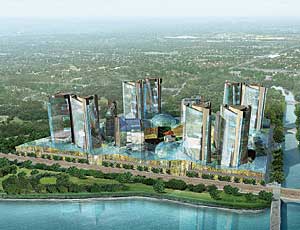After some highly publicized fits and starts, developer Robert Congel’s Pyramid Companies quietly started construction in late July on a 1.3-million-square-foot expansion of the Carousel Center mall in Syracuse, New York. It is intended to be the cornerstone of Destiny USA: a 75-million-square-foot retail, hotel, and entertainment complex touted as the world’s most sustainable project.
Congel is moving forward on Destiny thanks to a financing package worth $540 million, including $228 million in federal, tax-exempt green bonds designated for energy-conserving projects. This money, secured in February, was an important vote of confidence for a project that seemed dead in the water in early 2006. At the time, Pyramid and the city of Syracuse were deadlocked in a legal battle over tax abatements, and the community was suffering “promise fatigue” after Congel laid off most of its 210-person workforce.
But Pyramid’s legal troubles are now largely resolved. Construction teams from Cianbro are prepping the 10-acre Carousel site—work that includes driving steel piles 140 to 320 feet deep into lakeside clay soil—and Dal Pos Architects, a local firm that designed the original Carousel mall, is working on plans for the expansion’s first phase, which is due to be finished by the end of 2008. “A lot of people are breathing a sigh of relief: Okay, finally, here we go,” observes Michael Wasylenko, an economics professor at Syracuse University. “We’ve been talking about this long enough. Now it’s happening.”
In the short term, Destiny’s future is more modest than Congel once envisioned. The first phase will nearly double the 1.5-million-square-foot Carousel Center; unassuming, stepped concrete facades will mimic the existing, 17-year-old mall’s architecture. But Destiny could one day feature 1,000 shops and restaurants, 80,000 hotel rooms, a 40,000-seat arena, a water park, aquarium, and technology park. An enormous glass canopy would encase a large portion of the complex, shielding it from the 110 inches of snow that Syracuse receives on average each year.
Perhaps the most nontraditional aspect is who would actually build Destiny—and how. Congel has conceptualized what he calls a “unified workforce model,” whereby the same people who operate power tools on the construction site will later operate cash registers and stock shelves in stores at the mall. While building Destiny, these laborers will follow assembly instructions using handheld computers rather than paper blueprints. (RECORD’s parent company, McGraw-Hill, is co-sponsoring a series of conferences about some of these techniques this fall.)
Destiny will also showcase sustainability. The complex will have its own renewable-energy power plant, enabling it to operate independently of fossil fuels. A horizontal elevator system will transport people around the car-free mini-city, and a monorail will connect it to Syracuse’s airport and downtown. Pyramid also plans to incorporate more than 3,000 tons of coal ash into sidewalks and other concrete elements—one feature that led the U.S. Environmental Protection Agency to describe Destiny as “the world’s largest structure to be built from recycled industrial materials.” Congel is beginning to deliver on his green promises in the project’s first phase, which aims for LEED Gold certification. Construction vehicles are powered by 100 percent biodiesel fuel, and the building features a storm-water-capture system. In a show of support, the U.S. Green Building Council purchased $50,000 of the tax-exempt green bonds awarded to the project.
As for Destiny’s future, the Syracuse Industrial Development Agency agreed to provide Pyramid an undetermined amount in bonds for two additional phases, a 1,000-room hotel and 350,000 square feet of mixed-use space, which must be completed by 2013. But the developer still has a long way to go before securing the estimated $20 billion needed for the entire complex. “There are a lot of people who doubt [the expansion of Carousel] will ever lead to Destiny,” says Rick Moriarty, a reporter at The Post-Standard who has written hundreds of stories about the project since it was introduced in 2001. “So many delays, so many false starts. A lot of people think, ‘I’ll believe it when I see it.’ ”
David Aitken, a member of Destiny’s executive team, responds to such comments by taking the long view: “Like any large project, a lot of coordination needs to take place. We went through a period of challenges getting it off the ground. That is behind us now.”







Post a comment to this article
Report Abusive Comment